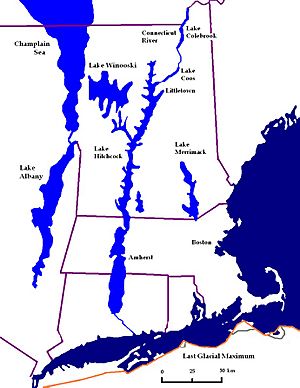Lake Merrimack facts for kids
Lake Merrimack was a huge lake that formed a very long time ago, during the end of the Pleistocene epoch. This time is also known as the last Ice Age. When the giant Laurentide Ice Sheet (a massive glacier) started to melt and shrink, its meltwater got trapped. This water built up behind a pile of rocky debris left by the glacier, called a moraine. This moraine blocked the Merrimack River, creating Lake Merrimack.
What Was Lake Merrimack?
Lake Merrimack was a long, narrow lake. It stretched from what is now Manchester all the way to Plymouth, New Hampshire. Imagine a huge lake covering parts of New Hampshire today! Scientists are not sure exactly when this ancient lake finally drained away.
How Did Lake Merrimack Form?
During the Ice Age, enormous glaciers covered much of North America. As the climate warmed, these glaciers began to melt. The melting ice created huge amounts of water. Sometimes, this water would get trapped by natural dams. These dams could be hills, mountains, or even piles of rock and dirt left behind by the glacier itself. In the case of Lake Merrimack, a "terminal moraine" acted like a dam. A terminal moraine is like a giant wall of rocks and sediment that a glacier pushes ahead of itself and then leaves behind when it melts. This natural dam held back the melting ice water, forming the lake.
What Are Varves?
Lake Merrimack, like other ancient glacial lakes, is important for understanding the geology of New Hampshire. It left behind special layers of sediment called varves. These varves are like nature's calendar!
- During the summer, when the glacier was melting a lot, fast-moving water carried silt and sand into the lake. These heavier sediments settled quickly, forming a light-colored layer.
- In the winter, the lake would freeze over. The water became very still, and only fine clay particles could settle to the bottom. These formed a darker, thinner layer.
Each pair of light (summer) and dark (winter) layers represents one year. By studying these varves, scientists can learn about the climate and how quickly the glaciers melted thousands of years ago.


